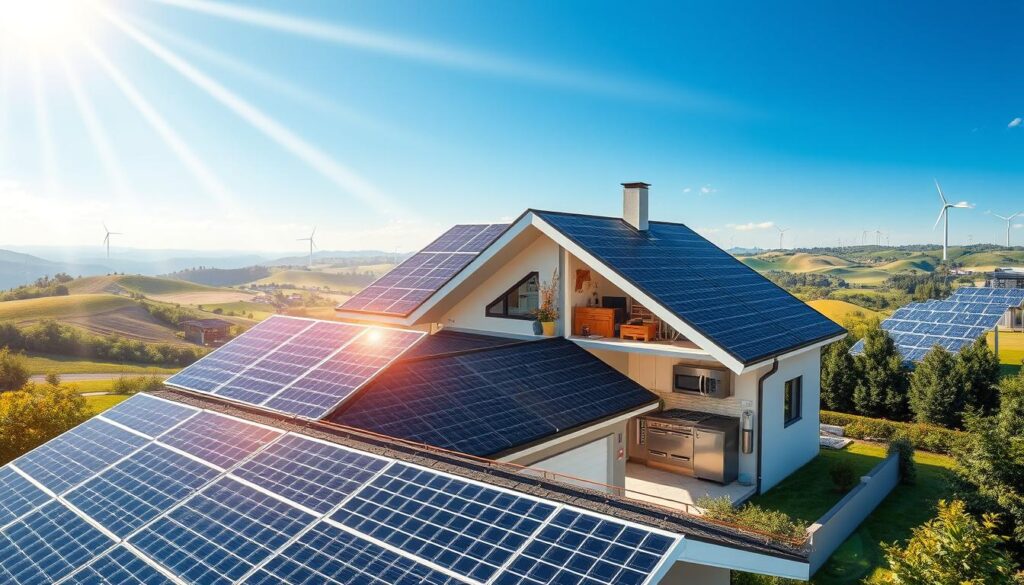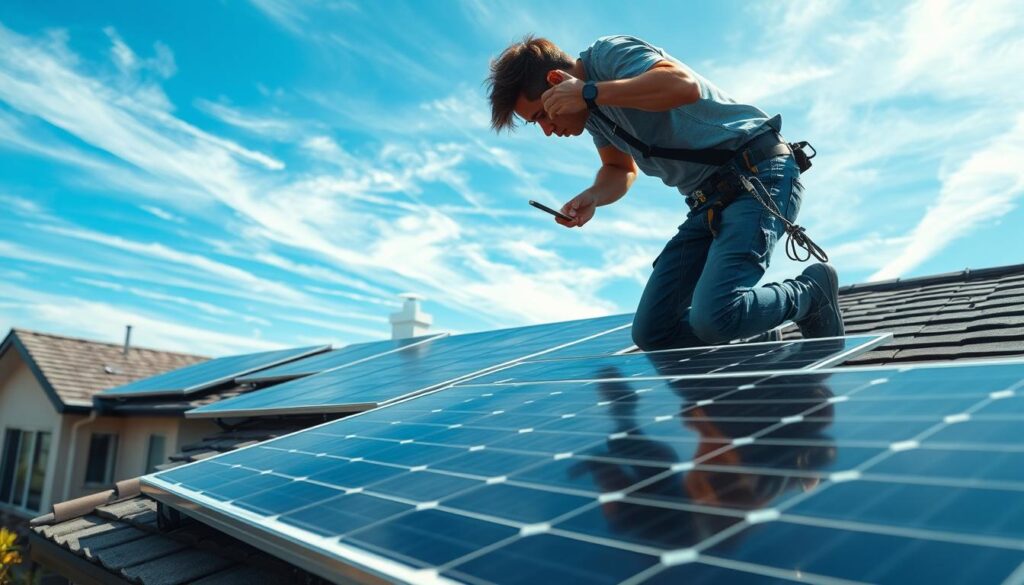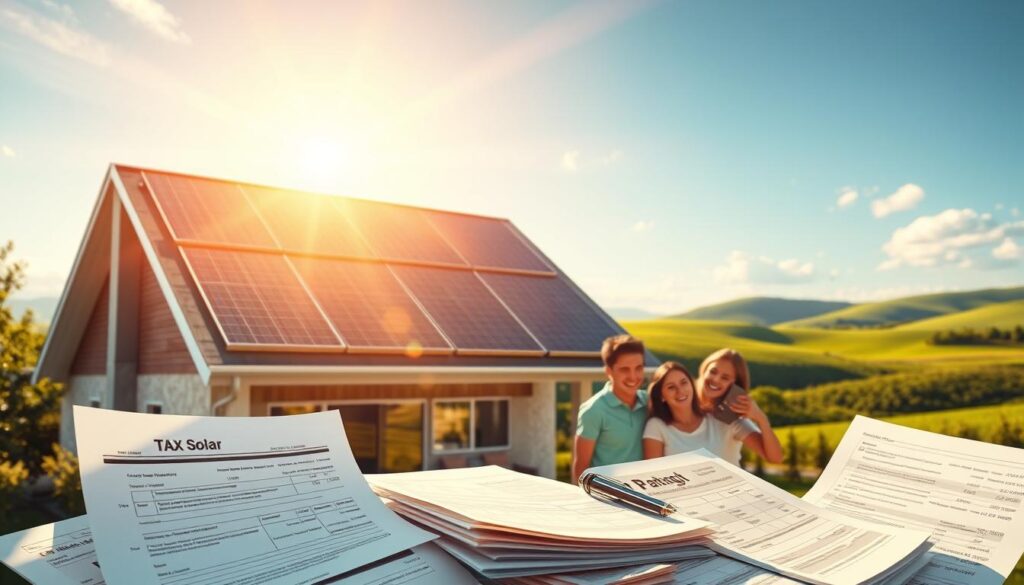More Americans are embracing solar energy as a smart and sustainable choice. With support from the U.S. Department of Energy, systems have become more affordable, making it easier for homeowners to switch. This shift not only reduces energy costs but also contributes to a cleaner environment.
Choosing solar is more than just an energy solution—it’s a long-term investment. Studies show that properties with solar installations can increase in value, offering financial benefits over time. Whether you’re looking to save on bills or reduce your carbon footprint, solar energy provides a practical and eco-friendly option.
This guide will walk you through the key benefits, recent trends, and how to get started. Let’s explore why going solar is a decision that pays off in more ways than one.
Key Takeaways
- Solar energy systems are more affordable due to government support.
- Reduces energy costs and lowers monthly utility bills.
- Increases property value and offers long-term financial benefits.
- Environmentally friendly, reducing carbon emissions.
- Works in all climates, including areas with snow or clouds.
Understanding the Basics of Solar Energy
Harnessing the sun’s energy has become a cornerstone of modern renewable solutions. At the heart of this process are solar panels, which capture sunlight and convert it into electricity. This transformation is made possible through photovoltaic technology, where sunlight excites electrons in the panel’s silicon cells, generating direct current (DC) electricity.
But the journey doesn’t end there. An inverter plays a crucial role in converting DC electricity into alternating current (AC), the type of electricity used in most households. Together, these components form the backbone of a solar energy system, ensuring efficient energy production and usage.
How Solar Panels and Inverters Work
Panels are designed to maximize exposure to the sun, even in less-than-ideal weather conditions. While efficiency may vary, modern systems are built to perform reliably across different climates. The inverter, often called the “brain” of the system, ensures the electricity produced is compatible with your property’s needs.
Key Components of a Solar Energy System
Beyond panels and inverters, a complete system includes mounting hardware, wiring, and sometimes batteries for energy storage. Each component is carefully selected and installed to optimize performance. The installation process involves assembling these parts and integrating them seamlessly into your property’s electrical setup.
By understanding these basics, you can appreciate the simplicity and sophistication of solar technology. It’s a system that not only meets your energy needs but also contributes to a sustainable future.
Overview of Benefits of Home Solar Power Systems
The shift toward sustainable energy is reshaping the way households manage their utility costs. By adopting clean energy solutions, homeowners can enjoy significant savings while contributing to a healthier planet. Let’s explore the key advantages of these systems.

Cost Savings and Reduced Utility Bills
One of the most immediate benefits is the reduction in monthly electricity bills. According to the U.S. Department of Energy, homeowners can save an average of $1,500 annually. Over time, these savings add up, making the initial investment worthwhile.
Additionally, the federal solar tax credit allows homeowners to deduct 30% of the installation cost from their taxes. This incentive, combined with state programs, makes switching to clean energy more affordable than ever.
Environmental Impact and Clean Energy Benefits
Clean energy systems significantly reduce carbon emissions. The EPA reports that the electric power sector contributes up to 25% of all greenhouse gases nationwide. By generating electricity from renewable sources, homeowners can lower their carbon footprint.
“Solar panels typically pay for themselves in terms of greenhouse gas emissions within 1 to 4 years of use,”
states the Office of Energy Efficiency and Renewable Energy. This makes clean energy a responsible choice for the environment.
Moreover, these systems promote energy independence, reducing reliance on traditional utility providers. This not only cuts costs but also ensures a more sustainable future for generations to come.
Evaluating Your Home’s Solar Potential
Determining your property’s suitability for renewable energy starts with a thorough evaluation. This process involves assessing key factors like roof condition, sunlight exposure, and energy usage. By understanding these elements, you can make informed decisions about the best option for your needs.
Assessing Sunlight Exposure and Roof Suitability
Your roof plays a critical role in determining energy potential. South-facing roofs are ideal in the northern hemisphere, as they receive the most sunlight throughout the day. East and west-facing roofs can also work, though they may produce less energy.
Shading from trees or buildings can significantly impact performance. Tools like the PVWatts Calculator from the National Renewable Energy Laboratory can help estimate energy yield based on your location and roof orientation.
Additionally, consider the size and pitch of your roof. Steeper pitches provide better exposure to sunlight, while larger roofs allow for more panels. Ensure your roof is in good condition to support the installation.
Analyzing Energy Usage and Savings Projections
Understanding your current energy usage is essential for calculating the amount of energy you’ll need. Review your utility bills to determine your average monthly consumption, typically measured in kilowatt-hours (kWh).
Based on this data, you can estimate the number of panels required. For example, a household using 1,000 kWh per month may need 20-25 panels, depending on their efficiency.
Professional consultations can provide accurate measurements and tailored recommendations. They’ll also help you explore financing options and available incentives.
| Factor | Considerations |
|---|---|
| Roof Orientation | South-facing is optimal; east and west are alternatives. |
| Shading | Minimize shading from trees or buildings for maximum efficiency. |
| Roof Size | Larger roofs allow for more panels, increasing energy production. |
| Energy Usage | Analyze monthly kWh consumption to determine panel requirements. |
| Professional Consultation | Experts provide accurate assessments and tailored solutions. |
Exploring Grid-Tied vs. Off-Grid Solar Options
Choosing the right energy system depends on your needs and location. Two popular options are grid-tied and off-grid systems. Each has unique benefits and challenges, making it essential to understand their differences.
Advantages and Limitations of Grid-Tied Systems
Grid-tied systems are the most common choice for homeowners. They connect to the local utility grid, ensuring a continuous power supply. One major benefit is net metering, where excess energy is sent back to the grid in exchange for credits.
This process reduces monthly bills and can even generate profit. However, grid-tied systems rely on the grid during outages, which can be a limitation in areas with frequent power interruptions.
When Off-Grid Solutions Make Sense
Off-grid systems are ideal for remote locations or areas with unreliable grid access. They operate independently, storing energy in batteries for use during cloudy days or at night. This setup eliminates electricity bills entirely but requires a higher upfront investment.
For example, properties more than 100 yards from the grid often find off-grid systems more economical. However, these systems demand careful energy management to avoid power shortages.
“Off-grid systems provide complete energy independence but require a significant initial investment and ongoing maintenance,”
Both options have their place, and the best choice depends on your location, energy needs, and budget. Consulting with a professional can help you navigate the decision-making process.
DIY Solar Installation and System Customization
Taking control of your energy needs has never been easier with DIY installations. By going solar on your own, you can save money while customizing a system that fits your specific requirements. Whether you’re a seasoned DIY enthusiast or a beginner, this guide will walk you through the essentials.

Essential Tools and Components for DIY Projects
To get started, you’ll need a few key tools and components. A typical DIY kit includes panels, inverters, racking, cables, and surge protectors. These kits often come with detailed instructions, making the process straightforward.
Investing in quality technology ensures your system performs efficiently. For example, a 1,000 W inverter is recommended for panels rated at 750 W. Additionally, a charge controller rated at 20A is essential for managing energy flow.
Step-by-Step Guide to Solar Installation
Begin by planning your system. Assess your energy needs using past utility bills to determine the number of panels required. For instance, a household using 1,000 kWh per month may need 20-25 panels.
Next, install the racking system on your roof or ground. Ensure it’s securely mounted and angled for optimal sunlight exposure. Connect the panels, inverter, and charge controller, following the kit’s instructions carefully.
Finally, test the system to ensure it’s functioning correctly. If you encounter challenges, consider consulting a professional company for assistance. Getting a quote beforehand can help you budget effectively.
“DIY installations can save up to 50% on costs compared to professional setups,”
While DIY projects are rewarding, they require careful planning and execution. For complex installations or if you’re unsure, hiring a company might be the best option. Either way, going solar is a step toward energy independence and long-term savings.
Understanding Solar Batteries and Energy Storage
Energy storage is a game-changer for modern renewable systems. It ensures that the energy you generate is available when you need it most, even during outages or at night. By integrating a reliable battery system, you can maximize the efficiency of your setup and reduce reliance on traditional grids.
Why Energy Storage Matters
Energy storage systems play a critical role in managing the intermittent nature of renewable energy. They store excess energy generated during peak sunlight hours for use during non-generating times. This not only enhances system reliability but also provides backup power during emergencies.
Choosing the Right Battery System
Selecting the right battery depends on several factors. Capacity, durability, and compatibility with your system are key considerations. For example, a household using 1,000 kWh per month may need a 4 to 8 kWh battery system.
Lithium-ion batteries are a popular choice due to their high efficiency and long lifespan. They can last up to 7,000 cycles, making them a worthwhile investment. Lead-acid batteries, while cheaper, have a shorter lifespan and lower depth of discharge.
“Lithium-ion batteries offer the best balance of performance and longevity, making them ideal for most setups,”
Types of Batteries and Warranties
Here’s a quick comparison of common battery types:
| Battery Type | Cost | Lifespan | Warranty |
|---|---|---|---|
| Lithium-ion | $499 – $1,499 | Up to 15 years | 10 years |
| Lead-acid | $100 – $449 | 5 – 10 years | 5 years |
| Lithium Iron Phosphate | $499 – $1,499 | Up to 15 years | 10 years |
High-quality batteries often come with extended warranties, ensuring long-term performance. They also qualify for federal tax credits, reducing the overall cost of your investment.
Maximizing Efficiency and Backup Power
Proper battery selection ensures your system operates at peak efficiency. For instance, lithium-ion batteries have a depth of discharge of up to 95%, allowing you to use most of their capacity. This makes them ideal for both short-term and long-term energy needs.
Additionally, energy storage systems provide quiet, reliable backup power during outages. This is especially valuable for property owners in areas prone to grid instability.
In conclusion, choosing the right battery system is essential for maximizing the benefits of your renewable energy setup. With the right choice, you can enjoy reliable energy, reduce costs, and contribute to a sustainable future.
Financial Considerations and Solar Incentives
Financial incentives make transitioning to clean energy a smart choice. With programs like the federal tax credit, the upfront price of installation becomes more manageable. These incentives not only reduce initial costs but also offer long-term savings on utility bills.

Federal and State Tax Credits
The federal Investment Tax Credit (ITC) allows homeowners to deduct 30% of their installation costs from their taxes. This credit applies to systems installed between 2022 and 2032, making it a significant financial benefit. For example, a $20,000 system could qualify for a $6,000 tax reduction.
State-level programs add even more value. In Minnesota, the Solar Sense Rebate Program offers upfront rebates based on system production. Combined with federal incentives, these programs make renewable energy accessible to more households.
Available Financing and Incentive Programs
Financing options like low-interest loans and Power Purchase Agreements (PPAs) help spread out costs. The FHA’s PowerSaver program, for instance, offers loans up to $25,000 with terms up to 20 years. These programs ensure that even those with limited upfront funds can make the switch.
Additionally, utility programs like Xcel Energy’s Solar*Rewards pay customers for every kilowatt-hour produced. Over ten years, these payments can offset a significant portion of the installation price.
“The federal ITC and state rebates make renewable energy a financially viable option for most homeowners,”
Navigating these programs can seem overwhelming, but resources like the Database of State Incentives for Renewables & Efficiency (DSIRE) simplify the process. By taking advantage of these incentives, you can enjoy both immediate savings and long-term financial benefits.
Choosing a Solar Installer and Reliable Equipment Providers
Selecting the right installer is a critical step in ensuring a smooth and efficient energy transition. A qualified professional not only guarantees a seamless installation but also provides valuable information to optimize your system’s performance. Here’s how to make the best choice for your needs.

What to Expect from a Qualified Installer
Start by verifying the installer’s credentials. Look for certifications like the North American Board of Certified Energy Practitioners (NABCEP), which is recognized as the gold standard in the industry. A reputable installer should also have at least three years of experience and a portfolio of successful projects.
Customer reviews and testimonials are essential for assessing reliability. Platforms like the Better Business Bureau (BBB) and Yelp offer insights into past clients’ experiences. Additionally, ensure the installer is licensed and insured, as this protects you during the installation process.
The Installation Process and Project Information
A professional installer will begin with a detailed consultation to understand your energy needs. They’ll assess your property, provide a customized plan, and explain the timeline and costs. Transparency is key—expect clear communication and a breakdown of all expenses.
During installation, proper metering and monitoring systems should be set up to ensure optimal performance. These tools allow you to track energy production and identify any issues early on. A reliable installer will also offer workmanship warranties, typically ranging from one to ten years.
Comparing Quotes and Verifying Reliability
When evaluating quotes, consider the cost per watt, which is calculated by dividing the total system cost by its capacity in watts. This metric helps you compare different installers effectively. Don’t hesitate to request detailed information about equipment, warranties, and subcontractor involvement.
“A reputable installer should be transparent about costs, timelines, and the extent of subcontractor involvement,”
Finally, ask about post-installation support. A trustworthy installer will provide maintenance services and be available for repairs if needed. By following these steps, you can confidently choose a professional who meets your expectations and ensures a successful energy transition.
Maintenance and Monitoring of Your Solar System
Ensuring your renewable energy system operates at peak efficiency requires consistent care and attention. Regular maintenance and advanced monitoring tools can significantly extend its lifespan and optimize performance. By staying proactive, you can maximize energy production and minimize potential issues.
Regular Maintenance Tips for Longevity
Keeping your system in top shape starts with simple yet effective practices. Cleaning panels 2-4 times a year removes dirt and debris that can reduce efficiency. Rainfall helps, but stubborn buildup may require manual cleaning with water and a soft brush.
Routine checks are equally important. Inspect panels for cracks, chips, or discoloration, and ensure mounting hardware is free from corrosion. Trimming nearby vegetation annually prevents shading, which can impact energy production.
After severe weather events, conduct a thorough inspection to identify any damage or performance drops. Professional maintenance every three years ensures comprehensive system checks and compliance with warranty requirements.
Leveraging Technology for Performance Monitoring
Modern monitoring tools make it easy to track your system’s performance in real time. Apps like SolarEdge’s mySolarEdge provide detailed insights into energy production, helping you identify irregularities quickly.
Online monitoring systems allow you to access data from anywhere with an internet connection. These tools send alerts for issues like drops in power output, enabling timely interventions. Monthly monitoring ensures your system operates efficiently, directly impacting your utility bill savings.
Advanced technologies like SafeDC™ enhance safety during maintenance by reducing voltage when the system is off. By integrating these tools, you can ensure your system remains reliable and efficient for years to come.
Conclusion
Making the switch to renewable energy offers both immediate and long-term rewards. From reducing your utility bills to lowering your carbon footprint, the benefits are clear. Systems designed to harness clean energy are more affordable than ever, thanks to federal and state incentives.
Now is the perfect time to evaluate your property’s potential. With advancements in technology and storage solutions, you can enjoy reliable energy year-round. Whether you’re looking to save money or contribute to a cleaner environment, the decision to go green is a smart one.
Take the next step today. Explore your options, consult with professionals, and discover how you can make a difference. The future of energy is here—don’t wait another year to embrace it.
